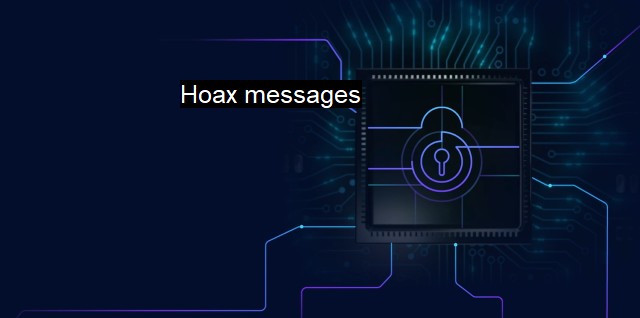What are Hoax messages?
Unveiling the Dangers of Hoax Messages in the Digital Age: Strategies for Protecting Cybersecurity
A hoax message is a form of communication designed to deliberately deceive its recipient. Often, these messages appear authentic and legitimate, when in fact they are engineered ploys instigated by entities with malicious intent. They are designed specifically to create unnecessary panic, manipulate individual or collective behavior, or achieve harmful objectives such as personal information theft or digital systems sabotage. hoax messages assume an even more ominous form given their potential for extensive harm and infrastructural disruption. Understanding the nature, purpose, and effects of such messages is indispensable in our digitally-connected world.One of the easiest ways to recognize a hoax message is by its main characteristics. Typically, they present alarming, shocking, or exciting news that urges the recipient to act immediately. This action required by the recipient is usually accompanied by a potential harm or loss if not fulfilled. Unfortunately, if the recipient falls prey to the message's manipulation, they subsequently aid in the unintentional spread of these hoax threats by relaying the message to their contacts. a hoax message can adopt a variety of forms ranging from emails and phone calls to sophisticated social engineering.
In the age of iterative technology advancement, hoax messages often aim specifically at tricking people to reveal their personal or financial information, or unknowingly download malicious software. Fraudsters carefully construct these messages to appear to be sent from reliable and credible sources. In an era where hackers continuously devise novel ways to intrude and scam their victims, versatile cyber skills such as recognizing the fake software, phishing emails, or unprotected links embedded within hoax messages become a precondition for every netizen.
Ranging from infecting devices with viruses to duplicating sensitive information, the consequences of falling for hoax messages can be dire. Sometimes, users end up losing valuable data or having their online accounts hacked. Worse yet, victims could find their identities stolen or become implicated in fraudulent actions without their consent or knowledge. Cybersecurity, manifested in the deployment of antivirus and secure network systems, among other mechanisms, is central to curbing abuse and mitigating damages afflicted via these malicious hoax messages.
An antivirus program plays a crucial role in combating the threats presented by hoax messages. Antivirus software can detect, prevent, and remove malware before it inflicts damage. advanced antivirus systems have sophisticated capabilities to scan, identify, and block deceptive hoax messages and potential phishing threats. But whilst antivirus software is a commendable first line of defense, it should coexist with a myriad of informed cybersecurity practices and awareness about these hoax messages.
Sadly, such messages have proliferated in direct proportion to the digitization of our daily lives. You have probably received numerous hoax messages in the guise of rewards, lottery winnings, or notices from credible corporations prompting you to update your confidential details. You may also have fallen victim to gratuitously persuasive bogus alerts that warn of non-existent viruses purported to wreak havoc on your device should you not comply or share these alerts with others.
In engaging with the digital world, it becomes crucial, more than ever, to distinguish the grain from the chaff when understanding and discerning the nature of the messages we receive. We must invest judiciously in robust cybersecurity infrastructure, adopt strong antivirus software, harbor a healthy skepticism of too-good-to-be-true communication, and educate ourselves continuously about the prevalent and evolving features of hoax messages; all towards proactively safeguarding our digital identities and associated assets.
Truly, in the age of intertwining technology and society, hoax messages have morphed into advanced tools enabling destructive, harmful actions. These seemingly innocuous messages have gone beyond duping individuals for sport and enabling acrimonious pranks to pioneering new vistas of cyber threats and security concerns. carefully devised countermeasures, continuous learning, and relentless scrutiny can work to ensure that we remain insulated and secure, disrupting the venue for such deceptive fraudulent intentions.

Hoax messages FAQs
What are hoax messages in cybersecurity?
Hoax messages in cybersecurity refer to false or misleading messages that claim to be true and cause panic, confusion or spread malware. These messages can be spread through emails, social media or messaging apps.What are the consequences of falling for hoax messages?
Falling for hoax messages can lead to numerous cybersecurity issues such as identity theft, data loss, financial fraud, and malware infections. Additionally, hoax messages can also cause panic and misinformation which can harm individuals and organizations.How can I identify hoax messages?
You can identify hoax messages by checking the source and verifying the information provided. Hoax messages often come from unknown or unusual sources and use language that creates urgency or panic. Before taking any action, verify the information with trusted sources and seek advice from cybersecurity experts.How can I protect myself from hoax messages?
To protect yourself from hoax messages, you should use reliable antivirus software, update your software and operating system, and avoid clicking on links or attachments from unknown sources. Additionally, be cautious of messages that ask for personal or sensitive information and always verify the source before taking any action. Lastly, stay informed and educate yourself about the latest cybersecurity threats and best practices.| | A | | | B | | | C | | | D | | | E | | | F | | | G | | | H | | | I | | | J | | | K | | | L | | | M | |
| | N | | | O | | | P | | | Q | | | R | | | S | | | T | | | U | | | V | | | W | | | X | | | Y | | | Z | |
| | 1 | | | 2 | | | 3 | | | 4 | | | 7 | | | 8 | | |||||||